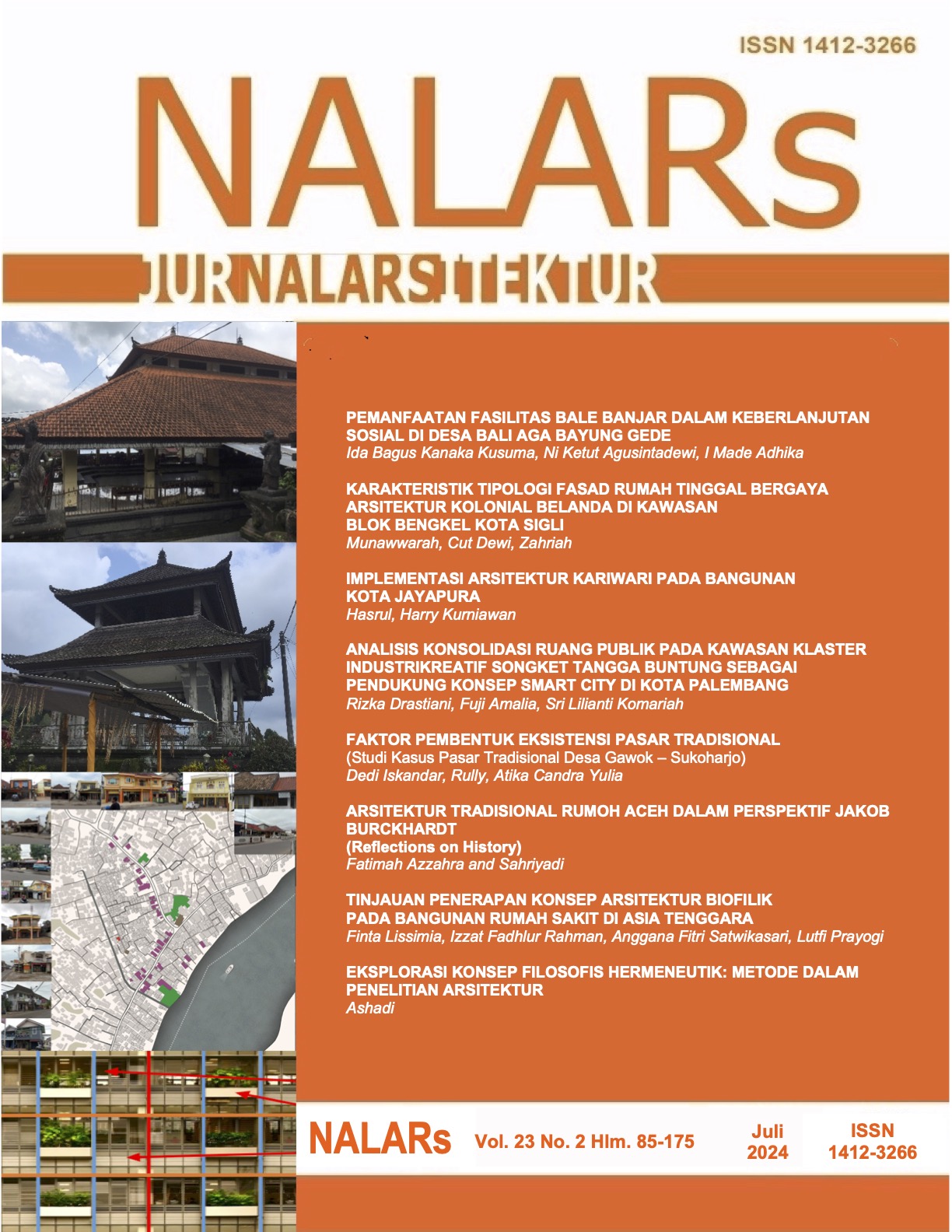TINJAUAN PENERAPAN KONSEP ARSITEKTUR BIOFILIK PADA BANGUNAN RUMAH SAKIT DI ASIA TENGGARA
DOI:
https://doi.org/10.24853/nalars.23.2.155-166Keywords:
Arsitektur Biofilik, Rumah Sakit, Asia TenggaraAbstract
Desain biofilik merupakan desain yang menitikberatkan pada hubungan antara manusia sebagai penggunan bangunan dengan elemen alam. Rumah sakit adalah sebuah fasilitas medis yang bertujuan untuk meningkatkan kualitas hidup masyarakat melalui proses pencegahan, penanganan, dan perawatan terhadap masalah kesehatan. Penelitian ini bertujuan untuk memahami desain biofilik pada rumah sakit dengan menggunakan studi kasus rumah sakit yang ada di Asia Tenggara. Metode yang digunakan yaitu quasi-kualitatif dengan materi penelitia 14 pola desain biofilik oleh Browning, Ryan, dan Clancy (2014). Pola tersebut ditrurunkan dari 3 prinsip desain biofilik yaitu nature in the spaces, nature analogues, nature of spaces. Prinsip desain biofilik akan dikaji menggunakan 14 pola desain biofilik oleh Browning, Ryan, dan Clancy (2014) pada siteplan, eksterior, dan interior Khoo Teck Puat Hospital Singapura, Ng Teng Fong Hospital Singapura, dan Rumah Sakit Pondok Indah Bintaro Jaya Indonesia. Penerapan Biofilik terbanyak ada pada Khoo Teck Puat Hospital karena lokasi dan siteplan mampu memaksimalkan kondisi alam di sekelilingnya. Meskipun ketiga rumah sakit terletak di kawasan perkotaan namun ketiganya mampu menerapkan konsep biofilik. Nature in Space dapat diterapkan pada siteplan, eksterior, dan interior ketiga rumah sakit. Nature analogues lebih banyak diterapkan pada interior. Sedangkan Nature of Space dapat diterapkan pada konfigurasi ruang dalam dan ruang luar termasuk lanskap. Biophilic architectur is a design that focuses on the relationship between humans as the use of buildings and natural elements. Hospital is a medical facility that aims to improve the quality of life of the community through the process of preventing, treating and treating health problems. This study aims to understand the biophilic design of hospitals using case studies of hospitals in Southeast Asia. The method used is quasi-qualitative with 14 biophilic design patterns by Browning, Ryan, and Clancy (2014). The pattern is derived from 3 principles of biophilic design, namely spatial properties, analogous properties, and spatial properties. The principles of biophilic design will be studied using 14 biophilic design patterns by Browning, Ryan, and Clancy (2014) on site plans, exteriors, and interiors of Khoo Teck Puat Hospital Singapore, Ng Teng Fong Hospital Singapore, and Pondok Indah Bintaro Jaya Hospital Indonesia. The most biophilic applications are in Khoo Teck Puat Hospital because the location and site plan are able to maximize the natural conditions around them. Although the third hospital is located in an urban area, the three are able to apply the biophilic concept. Nature in Space can be applied to the site plan, exterior and interior of all three hospitals. Natural analogues are more widely applied to interiors. Whereas Nature of Space can be applied to the configuration of space and outer space including landscapes.References
Almusaed, A., Alasadi, A., & Almssad, A. (2022). A Research on the Biophilic Concept upon School’s Design from Hot Climate: A Case Study from Iraq. Advances in Materials Science and Engineering, 1-12.
Avinç, G. M., & Selçuk, S. A. (2021). AN EVALUATION OF BIOPHILIC DESIGN PARAMETERS IN HOSPITAL BUILDINGS. International Congress on The Phenomenological Aspects of Civil engineering. PACE 2021.
Beute, F., & De Kort, Y. A. (2014). Natural Resistance : Exposure to Nature and Self Regulation, Mood, and Physiology After Ego-Depletion. Journal of Environmental Psychology, 167-178.
Browning, W., Ryan, C., & Clancy, J. (2014). 14 Pattern of Biophilic Design: Improving Health and Well-Being in the Built Environment. New York: Terrapin Bright Green, LLC.
Joye, Y. (2007). Architectural Lessons from Environmental Psychology: The Case of Biophilic Architecture. Review of General Psychology, 305-328.
Kellert, S. R. (2018). Nature by Design: The Practice of Biophilic Design. Yale University Press.
Khozaei, F., Carbon, C. C., Nia, M. H., & Kim, M. J. (2022). Preferences for Hotels with Biophilic Design Attributes in the Post-COVID-19 Era. Buildings, 1-13.
Korpela, K. (2003). Negative Mood and Adult Place Preference. Environment and behavior, 331-346.
Korpela, K. M., Hartig, T., Kaiser, F. G., & Fuhrer, U. (2001). Restorative Experience and Self-Regulation in Favorite Places. Environment and Behavior, 572-589.
Newell, P. B. (1997). A Cross-Cultural Examination of Favorite Places. Environment and Behavior, 495-514.
Rahman, I. F., & Lissimia, F. (2022). KAJIAN KONSEP BIOPHILIC PADA NG TENG FONG GENERAL HOSPITAL SINGAPURA. Jurnal Idealog Ide dan Dialog Indonesia, 11-23.
Rahman, I. F., & Lissimia, F. (2022). KAJIAN KONSEP BIOPHILIC PADA RUMAH SAKIT PONDOK INDAH BINTARO. Border: Jurnal Arsitektur, 15-28.
Sabaa, S. G., Azem, M. A., Al-Shanwany, H., & El-Ibrashy, M. (2022). A Study of Biophilic design and how it relates to the children's hospitals design. IOP Conf. Series: Earth and Environmental Science (pp. 1-12). IOP Publishing.
Tekin, B. H., Corcoran, R., & Gutie ́rrez, R. U. (2022). The impact of biophilic design in Maggie’s Centres: A meta-synthesis analysis. Frontiers of Architectural Research.
Zhong, W., Schro ̈der, T., & Bekkering, J. (2022). Biophilic design in architecture and its contributions to health, well-being, and sustainability: A critical review. Frontiers of Architectural Research, 114-141.

